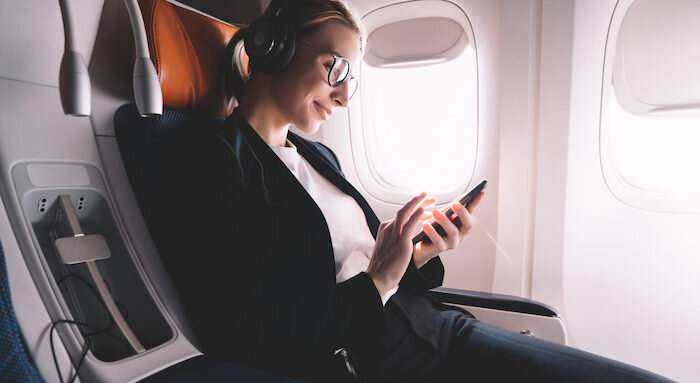
Flying can cause flare-ups and worsen chronic back pain for many people. Here are 9 key steps to take before and during your flight to better manage your back pain.
1. Strategically Schedule Your Flight
When you book your flight, think about the type of schedule that will be the least stressful.
- Consider taking a flight when there will be fewer people on board.
- Try to limit the downtime between in-flight connections or layovers, if applicable.
- Don't schedule a flight that will require you to wake up extremely early.
2. Contact the Airline
Weeks before your trip, call the airline to inform them you have a medical condition. With advance notice, they should be able to:
- Provide you with medical attention (if necessary) via wheelchair assistance and early boarding.
- Have airline personnel carry your luggage and/or lift it into the overhead bin for you.
- Accommodate you with special shuttles and elevator platforms for boarding.
- Give you tips for traveling (and getting through security), such as your transcutaneous electrical nerve stimulation (TENS) unit.
- Allow non-medical assistants to accompany you through security and boarding.
3. Ask Your Doctor for Help
Your doctor is one of your best advocates when preparing to manage your chronic back pain during air travel.
- If needed, ask your doctor to write a letter to your airline and flight crew. Your medical letter may be just what it takes to persuade the crew to allow special accommodations, such as being given access to more space to lie down flat and rest.
- Your doctor can also ensure that your prescription medication will last until you have returned home. You don’t want to run out of a prescription while away from home.
4. Bring Pain Medication with You on The Flight
- Taking your pain medication one hour before your flight to give it time to get into your system.
- Carry your pain medications together in a clear plastic bag and have them on you at all times, in case you need them during the flight.
- Inform flight attendants that you are on medication. This way they can monitor you if necessary.
If you use an over-the-counter medication, such as acetaminophen (Tylenol) or NSAIDs (Advil, Motrin), you may want to bring a few extra if the flight is particularly long. And remember to read labels carefully on all medications for safe use.
5. Provide Support to Your Back During the Flight
For lower back pain, providing support behind your lower back, often with a back roll or even a couple of pillows, is a good way to prevent slouching that may lead to back pain and to keep your spine straight.
Tube-shaped pillows with microfibers inside, back braces, and other materials providing support are common companions of passengers with back pain and can be purchased inexpensively at many stores.
6. Watch Your Posture
Airplane rides can be a bit tight and uncomfortable at times, especially if you’re not in first-class or business class.
- Keep your legs positioned at a right angle when you sit feet flat on the ground and knees about the same height as your hips. Doing so keeps stress off the lower back. If you need help to achieve this positioning, ask for something (pillows, blankets) to sit on or prop up your feet.
- If you have long legs, request an exit row or bulkhead seat, which generally has more legroom.
7. Move Around During the Flight
Staying stationary for prolonged periods of time stresses the spine and can make back pain much worse.
See if there is room at the back of the plane to do some quick stretching, which can provide more flexibility to the back and ease stiffness. Just be sure not to get up during turbulence.
8. Alternate Between Heat and Ice
For back pain that flares up during the flight, you might benefit from applying cold therapy or heat therapy. You could also consider alternating between both of them.
- Cold therapy can help reduce swelling and numb the pain. Consider asking the flight attendant to store your small gel pack in the fridge, or to fill your small plastic bag with ice.
- Heat therapy soothes tight muscles and promotes relaxation. Bring a heat wrap, or have the flight attendant fill your hot water bottle.
Remember to always have a layer of protection between your skin and the ice/heat source. Be sure to check with the airline regarding what items are acceptable to carry on. Whenever using a cold pack or heat wrap, read the directions carefully for safe use.
9. Relax and Try to Get Some Rest
A long flight provides plenty of time to relax. Try:
- Getting comfortable via a back or neck support, sitting properly, or reclining your seat.
- Breathing slowly (inhale deeply, count to five, exhale slowly, and repeat ten times) to relax your muscles and nerves.
- Listening to some soothing music in your headphones.
- Bringing a novel or other reading materials.
- Staring out at the clouds and scenery (if you have a window seat) and letting your mind drift.
Hopefully, these tips will help, and maybe even spark some more ideas of your own as you prepare to manage your back pain on your next plane ride.
Precision Pain Care and Rehabilitation has two convenient locations in Richmond Hill – Queens and New Hyde Park – Long Island. Call the Richmond Hill office at (718) 215-1888, or (516) 419-4480 for the Long Island office, to arrange an appointment with our Interventional Pain Management Specialist, Dr. Jeffrey Chacko.













